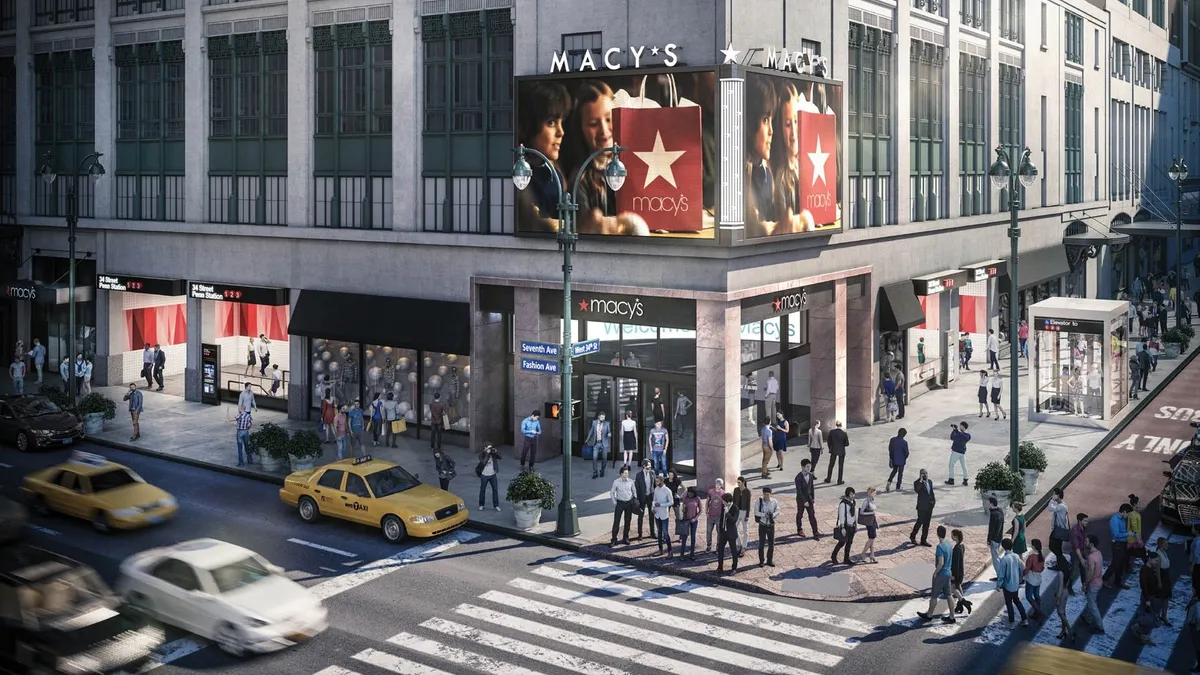Dive Brief:
-
Macy's may be rethinking its overall store strategy, but on Monday the company revealed plans regarding the renewal of its flagship location at Herald Square in New York City, according to Retail Dive.
-
The project involves a $235 million private investment in the neighborhood surrounding the store, including Herald Square's infrastructure, with upgraded subway access and improved transit connections. The company will also build a commercial office tower above the store.
-
Macy's forecast that the plan will generate $269 million in yearly city tax revenues, support 16,290 jobs and deliver over $4 billion in economic output annually. The Herald Square location will be open throughout the project's development.
Dive Insight:
The Herald Square store has been open since 1902, growing to a million square feet of retail space with a 1924 expansion along 34th Street and even further in 1931 when it annexed a Seventh Avenue building. Now Macy's is doubling down on its presence in New York City.
The company said the design is still being developed, but its work to revitalize its infamous flagship involves heavily investing in the infrastructure surrounding it. Macy's is working with various local officials and stakeholders on a multi-part plan that would transform Herald Square and Broadway Plaza into a car-free urban space for people to gather. That also means pouring money into improving the Herald Square subway station with new and more efficient entrances and connections, adding ADA-accessible elevators and creating additional pedestrian spaces.
The company has hinted at plans to revitalize this area for a number of years. In 2019 the retailer confirmed that it was working with government officials to build a commercial office tower at its Herald Square location, stating that it was "the best way to unlock the store's underlying real estate value and promote economic activity in the area." Even prior to that, in 2016 reports stated that the company was considering a renewal plan for the location.
"New York City is in Macy's DNA," the company states on its dedicated website about the project. "We are excited to make this commitment to New York City's economic recovery from an unprecedented global pandemic and continue to be a part of the city's success story."
Department stores were hit hard during the pandemic, but even before the global crisis they were struggling. Macy's in particular outlined a plan to move away from enclosed malls and over the years has faced criticism from analysts that it has too many locations. In February 2020, the retailer revealed a turnaround strategy, dubbed Polaris, which outlined a new approach to brick-and-mortar locations, a supply chain overhaul and e-commerce upgrades, among other points.
That plan, though, was quickly thwarted by the onset of COVID-19 in the United States, and eventually modified as consumer trends changed and many traditional retailers realized that digital channels could become more central to overall strategy.
Since that time, Macy's has made a number of other tactical moves, including launching a media network, opening 45 shop-in-shops of its off-price Backstage concept (with additional stand-alone locations on the horizon) and the closure of its Magnificent Mile location in Chicago.
S&P Global Ratings recently raised its outlook for the retailer from negative to positive, stating that "encouraging signs of an accelerating economic recovery are emerging, and we believe operating conditions for apparel retailers are fast improving."













